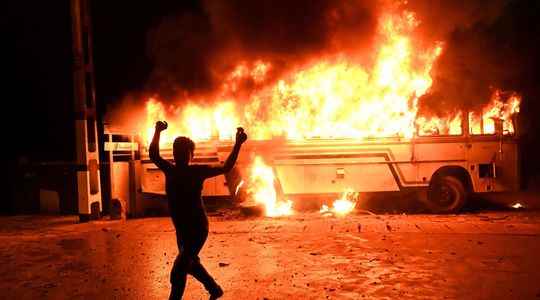Social networks were blocked this Sunday, April 3 in Sri Lanka and soldiers and armed police prevented an opposition demonstration against President Gotabaya Rajapaksa, as anger mounts in the country in the grip of an unprecedented economic crisis. Twitter, Facebook, Whatsapp, YouTube and Instagram were among the social networks made inaccessible across the country. Before this block took effect, anonymous activists had launched on the internet calls for new massive demonstrations this Sunday, accompanied by hashtags hostile to power, such as #GoHomeRajapaksas (“Outside the Rajapaksa”). “Don’t be deterred by the tear gas, very soon they will run out of dollars to restock,” urged a post on Saturday.
Several hundred people, led by opposition MPs, gathered outside the residence of opposition leader Sajith Premadasa on Sunday and began to march towards one of Colombo’s squares, defying the cover -fire in effect until Monday. But they were quickly prevented from advancing by a large group of soldiers and police carrying automatic assault rifles, according to an AFP photographer on the spot. In normal times, the army must content itself with a support role for the police. But with the state of emergency declared Friday evening by President Rajapaksa, it can intervene alone, in particular to arrest civilians.
“President Rajapaska had better realize that the tide has already turned against his autocratic rule,” said Harsha de Silva, MP for the opposition Samagi Jana Balawegaya (SJB) alliance. “We cannot tolerate a military takeover. They should know that we are still a democracy,” he added. Press photographers were denied access to Independence Square, the favorite ground of protesters in Colombo.
Saturday evening, a few hundred people had already defied the state of emergency and the curfew decreed on Friday, by demonstrating peacefully in several districts of Colombo and its suburbs. President Rajapaksa justified the exceptional measures by the “protection of public order and the maintenance of supplies and services essential to the life of the community”. During the night of Thursday to Friday, hundreds of demonstrators had gone to his home to demand his resignation, before the police used tear gas and water cannons.
Discord within power
And disagreements began to emerge within the power. “I will never condone the blocking of social networks,” criticized the Minister of Sports and nephew of the president, Namal Rajapaksa. “The availability of VPNs, like the one I’m using right now, makes this kind of blocking completely unnecessary,” he added. Gotabaya Rajapaksa is a member of a ruling family once loved by much of the country’s majority Sinhalese for bringing an abrupt end to the 2009 ethnic civil war against the Tamil Tigers. But support for the Rajapaksa clan collapsed with the economic crisis.
The country of 22 million people is facing severe shortages of essential goods, a sharp rise in prices and long power cuts, during its worst economic crisis since its independence in 1948. Tourism and remittances from the diaspora, vital to the economy, have collapsed during the pandemic, and authorities have imposed a broad ban on imports in an attempt to save foreign currency. Poor policy decisions have compounded the problems, economists say. Misguided tax cuts just before the pandemic starved the state of revenue and sent debt soaring. And the current crisis threatens to wipe out hopes for a revival in the tourism sector.
Sri Lanka has asked for help from the International Monetary Fund, but negotiations could last until the end of the year.
